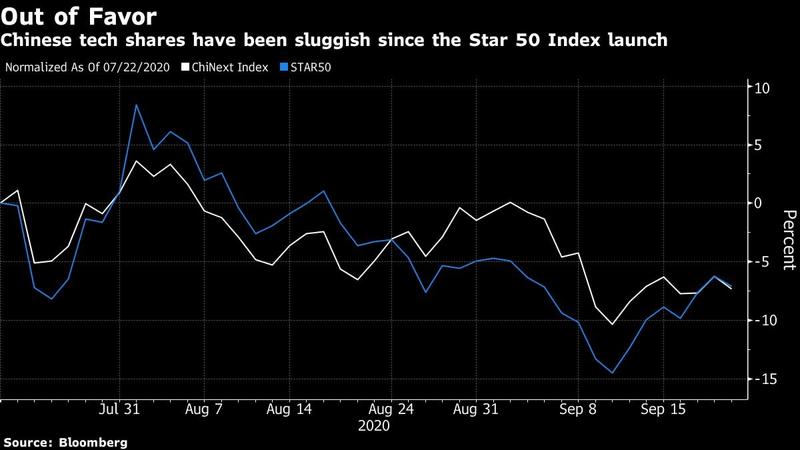 In this Oct 17, 2019 file photo, various figurines of the mascot for Ant Financial are displayed on a reception desk in the lobby of the company's headquarters in Hangzhou, China. (QILAI SHEN / BLOOMBERG )
In this Oct 17, 2019 file photo, various figurines of the mascot for Ant Financial are displayed on a reception desk in the lobby of the company's headquarters in Hangzhou, China. (QILAI SHEN / BLOOMBERG )
Some of China’s biggest fund houses are launching products that will give millions of mom-and-pop investors exposure to the nation’s soaring tech firms.
The new funds target investors with insufficient capital to buy stocks directly on the Star Board, where individuals are required to have a minimum 500,000 yuan in their trading accounts
Four exchange-traded funds tracking the Star 50 Index open for subscription on Tuesday and are expected to attract as much as 20 billion yuan (US$3 billion) between them. The ETFs are the first to directly replicate the index, which is derived from the nation’s newest stock venue aimed at fostering technology startups.
The launch comes just days after the Shanghai stock exchange approved Ant Group’s listing on its Star Board, setting the stage for a trading debut as soon as late October. Ant’s dual stock sale in Shanghai and Hong Kong may raise a combined US$35 billion, which would make it the world’s biggest initial public offering ever. The firm, owned by billionaire Jack Ma, would be a candidate for index inclusion after six months of trading, an addition that will force the ETFs to buy the shares.
READ MORE: Ant Group wins Shanghai nod for launch of giant dual IPO
The new funds target investors with insufficient capital to buy stocks directly on the Star Board, where individuals are required to have a minimum 500,000 yuan in their trading accounts. The issuers -- Huatai-PineBridge Fund Management Co, China Asset Management Co, E Fund Management Co and ICBC Credit Suisse Asset Management Co -- require a minimum investment of just 1,000 yuan for their products.

“These ETFs won’t just give China’s vast population of retail investors access to Star shares, they’ll also help bring in incremental flows to the board,” said Zhang Yankun, a fund manager with Beijing Hone Investment Management Co. “Index-tracking flows are key to ensure the stable and healthy development of the board.”
Two of the four new ETFs tracking China’s Star 50 Index received subscription orders exceeding their target of 5 billion yuan each, according to people with knowledge of the matter. At least two funds have hosted live-streaming events before the Tuesday’s launch to market their products.
ETFs can be traded in real time and in the US are growing increasingly complex and diverse since the first one came about in 1993. China’s first ETF was launched by China Asset Management Co about 12 years later. They only started to gain traction in China after MSCI Inc added yuan-denominated shares to its benchmarks in 2018.
Unlike other major stock markets in the US or Japan, China -- the world’s second largest -- isn’t overrun by ETFs. Individual investors haven’t caught on to the products even though costs can be a lot lower than with mutual funds, partly due to little demand for individual stock research.
READ MORE: China clamps down on finance arms of Ant, other giants
Despite this year’s growth -- ETFs in China nearly doubled in value in the first half -- there was still just US$157 billion invested in mainland-listed ETFs at the end of June, according to data compiled by Bloomberg. Equity funds account for about 0.3 percent of China’s stock market capitalization. The USETF market is worth more than US$4 trillion, with 75 percent of the funds tracking stock benchmarks.
For retail traders -- even those eligible to buy stocks directly through their trading accounts -- getting a slice of Ant’s IPO will be highly competitive. The retail portion for new shares on Shanghai’s Star board is often hundreds or even thousands of times oversubscribed, leaving many hopefuls without a single allocation.
READ MORE: Ant Group fuels tech IPO frenzy not seen since dotcom bubble
Buying into a cheap ETF might be the next best thing.
“It’s a pity I couldn’t participate earlier when some Star board firms recorded strong gains,” said Wendy Sun, a 27-year old financial sector worker in Shanghai. “Now with the funds’ lower investment threshold, I’ll definitely buy those instruments.”


